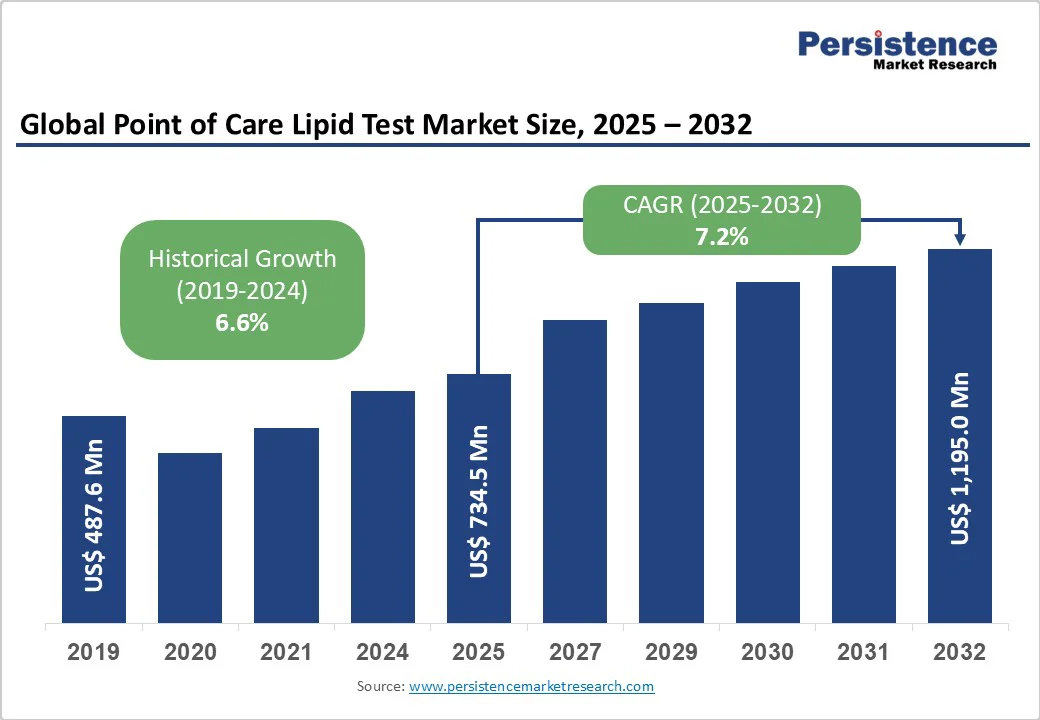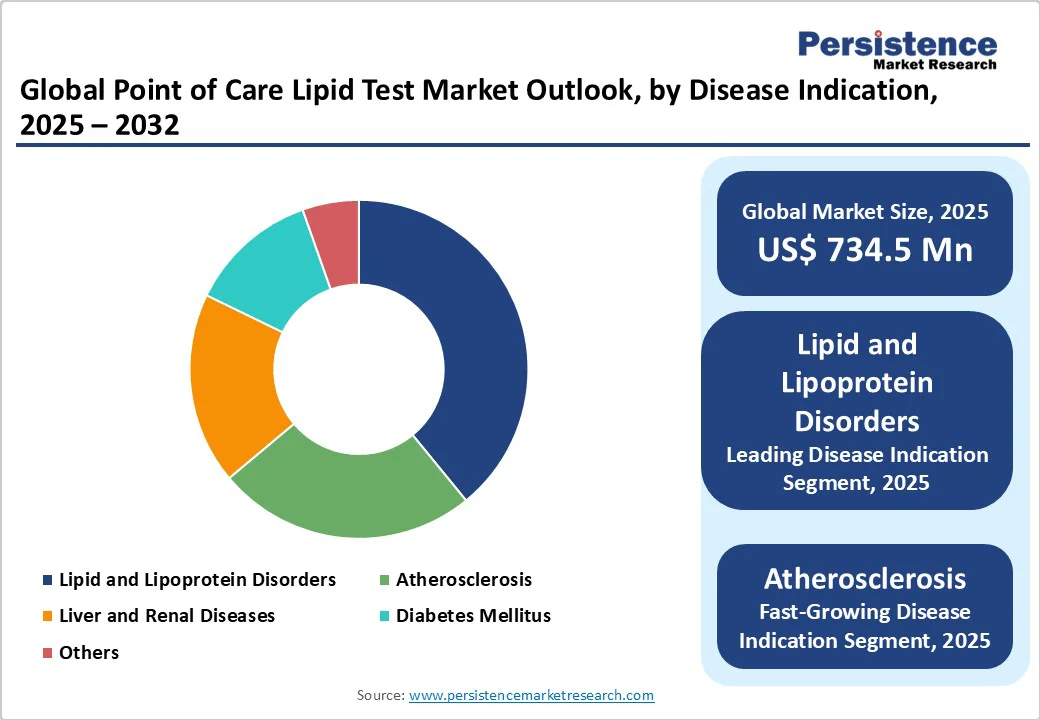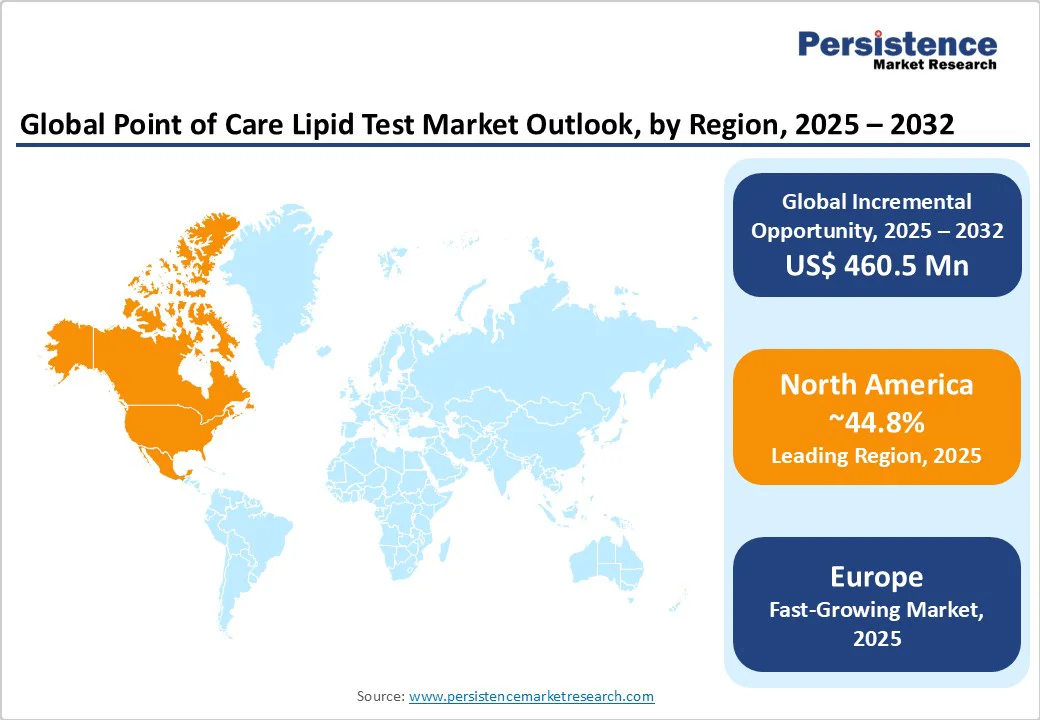ID: PMRREP35782| 184 Pages | 28 Oct 2025 | Format: PDF, Excel, PPT* | Healthcare

The global point of care lipid test market size is likely to be valued at US$734.5 Million in 2025 and is estimated to reach US$1,195.0 Million in 2032, growing at a CAGR of 7.2% during the forecast period 2025 - 2032, driven by the rising prevalence of heart disease, hyperlipidemia, and metabolic disorders worldwide. Healthcare providers in rural areas are adopting these quick diagnostic solutions.
| Key Insights | Details |
|---|---|
| Point of Care Lipid Test Market Size (2025E) | US$734.5 Mn |
| Market Value Forecast (2032F) | US$1,195.0 Mn |
| Projected Growth (CAGR 2025 to 2032) | 7.2% |
| Historical Market Growth (CAGR 2019 to 2024) | 6.6% |

Point of care lipid tests are increasingly valued for their ability to deliver accurate results outside centralized laboratories. This flexibility allows for testing in primary-care clinics, pharmacies, mobile health units, and community screening programs, specifically benefiting rural and underserved populations.
For example, in Southeast Asia, mobile health camps using POC lipid devices have successfully reached thousands of individuals who previously had limited access to diagnostic services. By bringing testing directly to patients, these solutions reduce barriers to care, enhance early detection, and support community-level preventive health initiatives.
The speed of POC lipid tests is a key driver of their adoption, as rapid results allow healthcare providers to identify cardiovascular and metabolic risks immediately. Early detection supports prompt lifestyle counseling, medication adjustments, or referral to specialists, thereby improving chronic disease management.
Recent programs in Europe have demonstrated that same-visit lipid profiling in outpatient clinics leads to quick risk stratification and high patient engagement. These help improve adherence to preventive strategies and reduce long-term complications.
One of the main challenges for point of care lipid tests is the potential for slightly lower accuracy compared to traditional laboratory testing. Variations in sample handling, environmental conditions, or device calibration can occasionally lead to misleading results, which may affect diagnosis or treatment decisions.
For instance, some studies in the U.S. have shown that certain handheld lipid analyzers can deviate from lab-based results by up to 10%, prompting clinicians to confirm abnormal readings with conventional testing. This concern can slow adoption in hospitals or high-risk patient populations where precision is important.
POC lipid test results can be influenced by the quality of the blood sample. Hemolysis, jaundice, or high lipid content in samples may interfere with accurate measurement, producing unreliable readings.
In India, community health programs reported that around 8% of tests had to be repeated due to visibly lipemic or hemolyzed samples, emphasizing the challenge of ensuring consistent sample integrity in field settings. Such limitations tend to reduce clinician confidence and hinder large-scale deployment in diverse environments.
The integration of smartphones into POC lipid testing is opening new avenues for personalized healthcare. Modern devices can use a phone’s camera to interpret test results, while apps analyze the data, calculate cardiovascular risk scores, and securely share results with clinicians.
This approach enables real-time monitoring, remote consultations, and smooth patient management, especially in regions with limited access to healthcare facilities. For example, recent pilot programs in India have successfully used smartphone-assisted lipid testing in rural health camps, further improving early detection rates and enabling timely interventions.
Developments in POC technology are now allowing clinicians to obtain a comprehensive metabolic profile from just one drop of blood. Devices capable of simultaneously measuring total cholesterol, HDL, triglycerides, and glucose are reducing the requirement for multiple tests, thereby saving time and improving patient compliance.
In Japan, clinics adopting these multi-analyte devices have reported quick diagnostic workflows and improved preventive care. This is because patients can receive a clear picture of their cardiovascular and metabolic health in only one session.
Consumables are expected to account for nearly 62.3% of the share in 2025 as test strips, cartridges, and reagents require frequent replacement for every test conducted. This creates recurring demand in hospitals, clinics, and community health programs. For example, Europe-based outpatient clinics report that test strips account for the majority of ongoing costs in lipid monitoring, reinforcing their central role in sustaining the market.
Instruments are gaining traction due to developments in portability, speed, and digital connectivity. Modern devices deliver multi-analyte measurement, smartphone integration, and cloud-based result storage, making them highly attractive for both clinics and home use. In Japan, clinics adopting these compact analyzers have refined patient workflows, enabling same-visit cardiovascular risk assessment.
Lipid and lipoprotein disorders are speculated to capture approximately 39.1% of the share in 2025, as disorders involving cholesterol and lipoproteins remain the primary segment. This is because they are major risk factors for cardiovascular disease, the leading cause of mortality globally. Rising awareness of early detection and preventive care propels demand for routine cholesterol and HDL/LDL monitoring.
Atherosclerosis is witnessing steady growth in POC testing due to its silent progression and association with heart attacks and strokes. Rapid lipid profiling helps identify at-risk patients early. Recent programs in the U.K. showed that same-day lipid testing during routine checkups improved early atherosclerosis risk detection by 25%.
Hyperlipidemia is projected to record a share of about 47.9% in 2025, as it affects a large population and requires regular monitoring to guide lifestyle changes and medication. In community health initiatives in India, screening for hyperlipidemia enabled timely interventions in nearly 30% of adults tested.
Hypertriglyceridemia is steadily surging as an application due to its link with metabolic syndrome, diabetes, and cardiovascular risk. Lifestyle changes and dietary patterns in Asia Pacific are contributing to high triglyceride levels, prompting increased POC testing for early detection and management.

North America will likely account for approximately 44.8% of the share in 2025, owing to high cardiovascular disease prevalence, aging populations, and superior healthcare infrastructure. The U.S. market is characterized by widespread adoption across hospitals, clinics, and pharmacies, facilitated by user-friendly devices that enable rapid cholesterol profiling. This trend caters to the increasing emphasis on preventive healthcare and early disease detection in the country.
Technological developments such as biosensor-based devices and integrated digital connectivity are improving the accuracy and usability of POC lipid tests. In addition, government initiatives targeting early detection of cardiovascular risk factors and lifestyle-related diseases are projected to fuel regional adoption. Recent developments include Heska Corporation's acquisition of MBio Diagnostics, Inc. in January 2023, to improve POC testing ranges.
In Europe, the market for POC lipid tests is experiencing steady growth, propelled by increasing cardiovascular disease rates and a rising focus on preventive healthcare. Germany, the U.K., and France are at the forefront, integrating POC lipid testing into primary care clinics, pharmacies, and mobile health units to facilitate early detection and continuous monitoring. The adoption of portable devices and digital platforms that store and share results is improving accessibility, even in rural areas.
In the U.K., public interest in accessible diagnostic options is evident, with a 2024 survey revealing that 86% of the population believes fast testing could help reduce the NHS backlog. This sentiment is pushing the demand for convenient testing solutions, including POC lipid tests, in clinics, pharmacies, and home settings.
Germany's well-developed healthcare system and emphasis on early detection of heart disease are contributing to growth. Routine screenings in clinics and employer health programs are raising demand, while the use of portable and digital testing tools is making lipid monitoring more accessible.
Asia Pacific is currently experiencing considerable growth, supported by a rising prevalence of cardiovascular and metabolic disorders. China, India, Japan, and South Korea are at the forefront, witnessing increased healthcare demand as large populations grapple with conditions such as hyperlipidemia. Unique applications of POC lipid testing are emerging, particularly in schools.
For instance, in 2024, a pilot program in a key city in Asia Pacific demonstrated the feasibility of using POC lipid tests in schools, identifying approximately 20% of adolescents with unhealthy cholesterol levels. These tests require only a tiny blood drop and deliver results in about five minutes, making it feasible to test hundreds of students per session.
Technological developments are improving the accessibility and efficiency of POC lipid testing in Asia Pacific. Recent developments include the introduction of at-home test kits that utilize a simple fingerstick method and provide results in 10 to 15 minutes, making testing accessible and less invasive for users. The World Health Organization's Package of Essential Noncommunicable (PEN) Disease Interventions package lists tests for hyperlipidemia as essential in primary care.

The global point of care lipid test market is highly competitive, featuring a blend of established global healthcare giants and specialized diagnostic companies. Leading players include Abbott Laboratories, F. Hoffmann-La Roche Ltd., Nova Biomedical, SD Biosensor, Inc., and Menarini Group, collectively accounting for approximately 40% of the global market share. These companies use superior research and development capabilities, extensive distribution networks, and established brand reputations to maintain their market positions.
The point of care lipid test market is projected to reach US$734.5 Million in 2025.
Rising cardiovascular disease prevalence and high demand for on-site cholesterol monitoring are the key market drivers.
The point of care lipid test market is poised to witness a CAGR of 7.2% from 2025 to 2032.
Expanding POC testing in rural areas and integration with multi-analyte devices are the key market opportunities.
Callegari Sri, Sinocare Inc., and Abbott Laboratories are a few key market players.
| Report Attribute | Details |
|---|---|
| Historical Data/Actuals | 2019 - 2024 |
| Forecast Period | 2025 - 2032 |
| Market Analysis | Value: US$ Mn |
| Geographical Coverage |
|
| Segmental Coverage |
|
| Competitive Analysis |
|
| Report Highlights |
|
By Product Type
By Disease Indication
By Application
By Region
Delivery Timelines
For more information on this report and its delivery timelines please get in touch with our sales team.
About Author